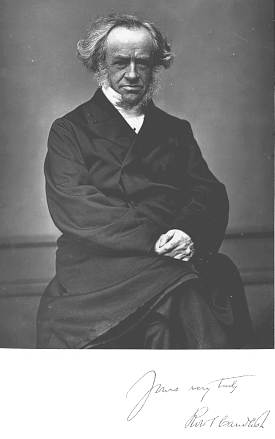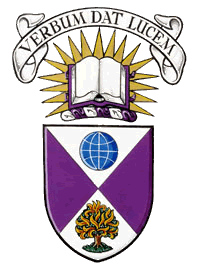
Robert Smith Candlish was a Scottish minister who was a leading figure in the Disruption of 1843. He served for many years in both St. George's Church and St George's Free Church on Charlotte Square in Edinburgh's New Town.

The Disruption of 1843, also known as the Great Disruption, was a schism in 1843 in which 450 evangelical ministers broke away from the Church of Scotland to form the Free Church of Scotland. The main conflict was over whether the Church of Scotland or the British Government had the power to control clerical positions and benefits. The Disruption came at the end of a bitter conflict within the Church of Scotland, and had major effects in the church and upon Scottish civic life.

Thomas Forsyth Torrance, commonly referred to as T. F. Torrance, was a Scottish Protestant theologian and Presbyterian minister. He was a member of the famed Torrance family of theologians. Torrance served for 27 years as professor of Christian dogmatics at New College, in the University of Edinburgh. He is best known for his pioneering work in the study of science and theology, but he is equally respected for his work in systematic theology.

Knox College is a postgraduate theological college of the University of Toronto in Toronto, Ontario, Canada. It was founded in 1844 as part of a schism movement in the Church of Scotland following the Disruption of 1843. Knox is affiliated with the Presbyterian Church in Canada and confers doctoral degrees as a member school of the Toronto School of Theology.

St Mary's College, founded as New College or College of the Assumption of the Blessed Virgin Mary, is the home of the Faculty and School of Divinity within the University of St Andrews, in Fife, Scotland.
George McLeod Newlands is a Scottish theologian widely published in the fields of modern systematic theology, Christology, emancipatory theology, and the history of Christian thought. He is Emeritus Professor of Divinity at the University of Glasgow, and served as Chair of the Theology, Divinity & Religious Studies panel of the UK's 2008 Research Assessment Exercise and as President of the Society for the Study of Theology for 2013–14.
Trinity College, Glasgow, Scotland, is the Church of Scotland's College at the University of Glasgow. It provides special supervision of candidates for the ministry through a Principal and a College Council. The college is the official channel of liaison between the University of Glasgow, the Church of Scotland, and the United Free Church of Scotland.

John Baillie was a Scottish theologian, a Church of Scotland minister and brother of theologian Donald Macpherson Baillie.

Thomas M'Crie was a Presbyterian minister and church historian. He was a Scottish Secession minister who joined the Free Church of Scotland and served as the Moderator of the General Assembly to that church 1856/57.

Christ's College was one of three colleges in Scotland founded by the Free Church of Scotland for the training of ministers following the Disruption of 1843. The other two were New College, Edinburgh and Trinity College, Glasgow.

John Duncan, also known as "Rabbi" Duncan, was a minister of the Free Church of Scotland, a missionary to the Jews in Hungary, and Professor of Hebrew and Oriental Languages at New College, Edinburgh. He is best remembered for his aphorisms.
David Alexander Syme Fergusson is a Scottish theologian and Presbyterian minister. Since 2021, he has been Regius Professor of Divinity at the University of Cambridge.

William Menzies Alexander was a Scottish medical and theological writer. He was Moderator of the General Assembly for the Free Church of Scotland for 1911/12.

David Brown was a son of bookseller who was twice Provost of the city. He was a Free Church of Scotland minister who served as Moderator of the General Assembly 1885/86. He was co-author of the Jamieson-Fausset-Brown Commentary on the whole Bible.
David F. Wright (1937–2008) was an English-born historian, who taught for almost a half-century at University of Edinburgh's New College.
Thomas Smith was a Scottish missionary and mathematician who was instrumental in establishing India's zenana missions in 1854. He served as Moderator of the General Assembly of the Free Church of Scotland 1891/92.

James Julius Wood (1800–1877) was a 19th-century Scottish minister who served as Moderator of the General Assembly of the Free Church of Scotland 1857/8.
James Smith Candlish (1835–1897) was a Scottish minister of the Free Church of Scotland who was a professor of theology in Glasgow.

Alexander Black DD was professor of Exegetical Theology in New College, Edinburgh. Black was a native of Aberdeen, where he received his education, first at the Grammar School, and afterwards at Marischal College. After passing through the Divinity Hall, he was appointed assistant to Dr Ross, East Church, Aberdeen, and he was subsequently presented to the Parish Church of Tarves, as successor to Duncan Mearns. Upon the death of David Brown, Black in 1831 became his successor in the Professorship of Divinity in Marischal College. His knowledge of Hebrew and the cognate tongues procured him, in 1839, a place in a deputation sent by the General Assembly to Palestine. At the disruption, Black attached himself to the Free Church, and in 1844 was appointed to the chair of Exegetical Theology in the New College, Edinburgh, from which he retired in 1856. He was a versatile linguist who, it is said, could converse in nineteen languages and correspond in twelve.

The New College Settlement was a student settlement based on the Pleasance in the Southside of Edinburgh, Scotland. Founded by students of New College in 1893, its work continued until 1952.




















